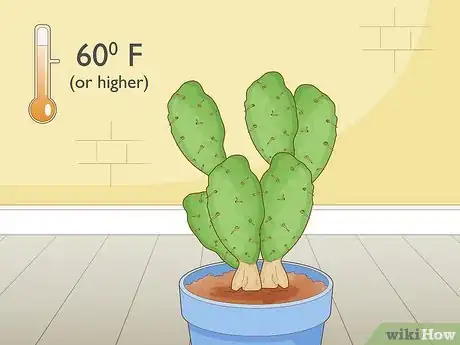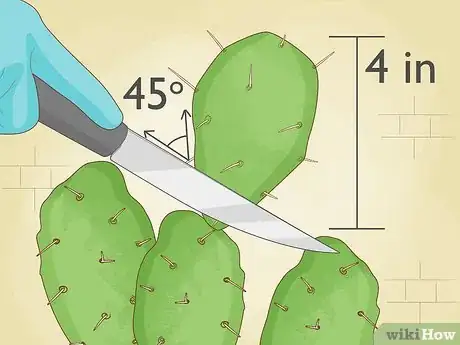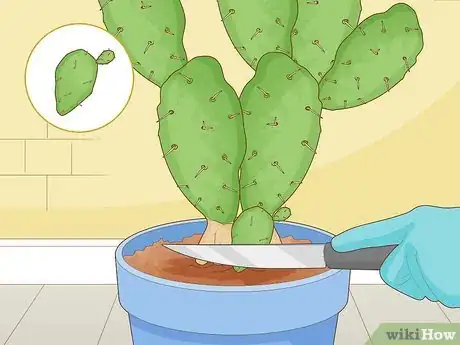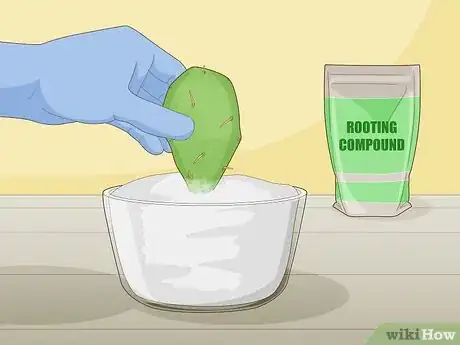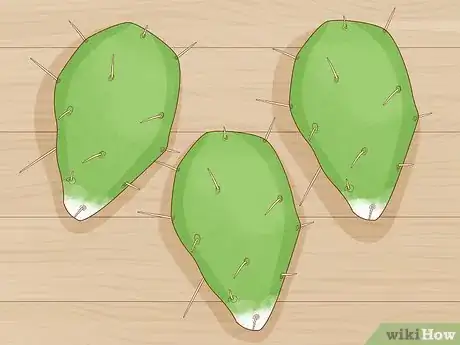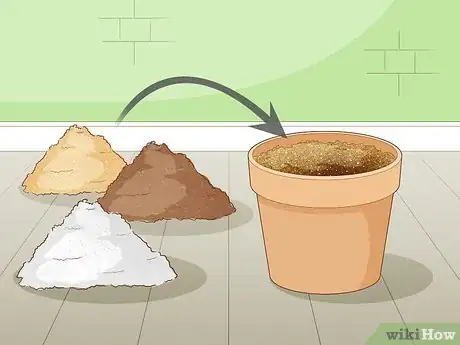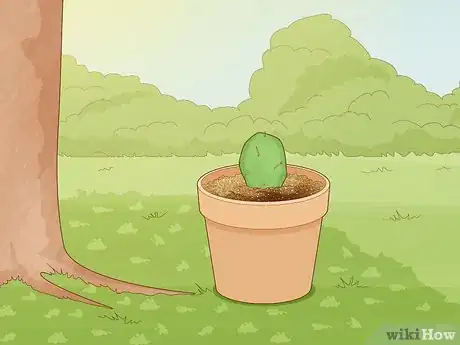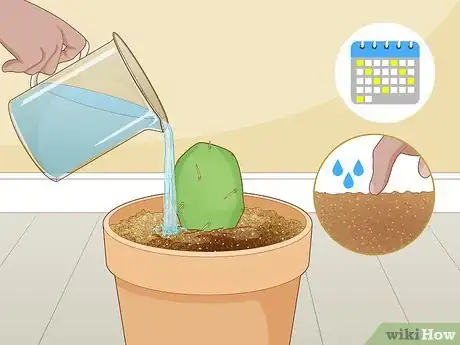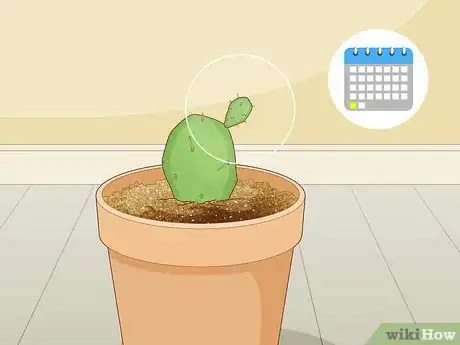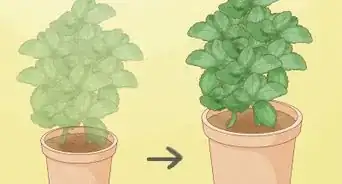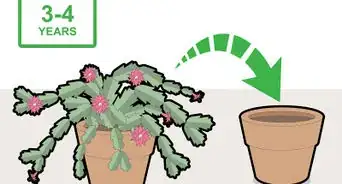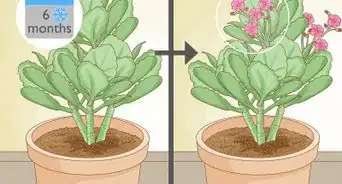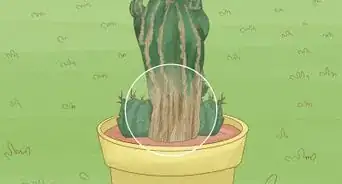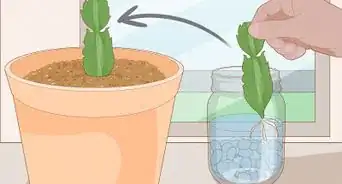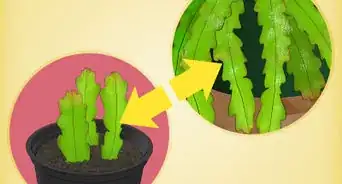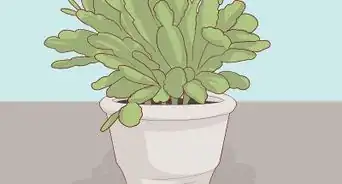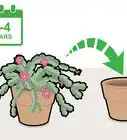This article was co-authored by Chai Saechao and by wikiHow staff writer, Janice Tieperman. Chai Saechao is the Founder and Owner of Plant Therapy, an indoor-plant store founded in 2018 based in San Francisco, California. As a self-described plant doctor, he believes in the therapeutic power of plants, hoping to keep sharing his love of plants with anyone willing to listen and learn.
This article has been viewed 25,646 times.
If you’re looking for a hardy, low-maintenance plant to keep around your home, then a cactus might be a great option.[1] These plants can be easily grown from cuttings, and you can care for them with some basic gardening supplies. With enough TLC and patience, you might be able to root your own cactus!
Steps
Cutting the Cactus
-
1Take your cuttings in late summer or early fall for the best results. Wait for the weather to be cool and dry, with nighttime temperatures averaging around 60 °F (16 °C) or higher. This is usually between the months of August and October.[2]
- Cactus cuttings are mostly likely to thrive in sunny climates with warm daytime temperatures.
- Don’t try to root a cactus if you live in a place that’s cold all the time.
-
2Slide on a pair of gloves to protect your hands. Since you’re handling a fully-grown piece of cactus, protect your fingers from pricks or cuts by wearing a pair of sturdy gloves. If you don’t have gloves on hand, wrap your fingers with medical tape instead.[3]Advertisement
-
3Cut off a healthy 4 in (10 cm) stem at a 45-degree angle. Wipe down the surface of a serrated knife with a diluted bleach solution to get rid of any germs or bacteria, then slice off a short piece of cactus that’s a little over 4 in (10 cm) long. If you’re using a padded cactus, slice through the joint that’s connecting both of the pads.[4]
- The bleach solution needs to be a 1:10 ratio of bleach to water.
- Don’t use pruning shears to remove the cutting, as this could make it harder for the cactus to grow and propagate in the long run.
- Trim away any smaller leaves attached to the bottom of the cutting so you can plant it more easily.
-
4Slice off any offsets growing from the cactus. Note that some cacti plants sprout pups or offsets, which are small growths emerging from the side of the plant. Use a knife to cut this smaller growth, or “pup,” from the main plant. Try to leave at least a few millimeters of stem attached to the main plant whenever you remove a pup.[7]
Prepping and Replanting the Root
-
1Dust the exposed end of the cutting with a rooting compound. Visit a gardening store or online shop to purchase a special rooting compound or powder, which helps the cutting to heal properly. Dip the freshly cut end of the cactus in a bowl of rooting hormone (also known as rooting compound).[8]
-
2Let the cutting sit for a week or so until a callus forms. Find a flat, dry space to place your cactus cutting so it can air-dry. Monitor the plant on a regular basis to see if a hardened coating or callus develops along the cut end. As you check, make sure that the bottom is completely dry before doing anything with the plant.[9]
- You can leave your cactus in a well-lit or dark area, as long as the plant stays dry.
- Don’t be alarmed if you don’t see a callus form right away! In extreme cases, it might take months for a full callus to form. The callus will look very light green and be completely dry to the touch.[10]
-
3Fill a planting pot with a special propagation mixture or cactus medium. Mix equal parts of perlite or pumice with compost or peat to create a healthy growing environment for your cactus cutting. Once you’ve created this mixture, pour it into a planting pot.[11]
- Unlike other plants, succulents need some inorganic material in the soil to root successfully.
-
4Insert the bottom third of the cutting into the soil and gently pack soil around it. Place the cutting so it stands upright in your planting pot. Aim to cover the bottom third or half of the plant with soil mixture to prevent the cactus from tipping over. Lightly press soil around it to keep the cutting standing upright.[12]
- If you’re working with a columnar cactus, you might need to cover even more of the plant with soil.
-
5Place the pot in an area that gets indirect sunlight and partial shade. Find an outdoor area with indirect sunlight, preferably near overhanging trees. If possible, arrange your cutting beneath the branches of a tree, which provides an equal amount of shade and sunlight.[13]
- Make sure that your cactus cuttings get a consistent amount of partial sunlight throughout the day.
Caring for the Rooted Cactus
-
1Water the cutting once every few days when the soil feels dry. Pour water over the base of the plant to nourish the new cutting. Try to use fresh or distilled water for this, as this can help bacteria from developing around your plant. After this, water the plant every 3-4 days to keep the soil lightly moist.[14]
- If your water has a lot of chlorine in it, use distilled water instead.
Tip: To help your plant through the transition process, water the cactus immediately after transplanting it![15]
-
2Wait several weeks for signs of new growth. Keep an eye on your cutting to see how much progress it has made. Wait 3-4 weeks for your cutting to develop substantial roots. Specifically, check the top of the plant to see if it looks any taller or wider than when you first planted it.[16]
- You can leave the cuttings in the container for up to 1 year.[17]
-
3Transfer the rooted cactus to a new pot. Fill a pot with a mixture of a gritty planting substance, like pumice, as well as some compost. Use a spoon and a pair of tweezers to lift and remove the developing seedling from its original location and plant it in the pot. If needed, fill in the area around the cactus with soil.[18]
Expert Q&A
-
QuestionDo cacti or succulents take more effort to care for?
 Chai SaechaoChai Saechao is the Founder and Owner of Plant Therapy, an indoor-plant store founded in 2018 based in San Francisco, California. As a self-described plant doctor, he believes in the therapeutic power of plants, hoping to keep sharing his love of plants with anyone willing to listen and learn.
Chai SaechaoChai Saechao is the Founder and Owner of Plant Therapy, an indoor-plant store founded in 2018 based in San Francisco, California. As a self-described plant doctor, he believes in the therapeutic power of plants, hoping to keep sharing his love of plants with anyone willing to listen and learn.
Plant Specialist It really depends on the specific species of each plant, but you can't go wrong with either one of them. They both tend to require less sunlight than a lot of other plants, and you don't typically need to water them very often. A cactus might be a little easier to care for since you don't need to water them at all in the colder months.
It really depends on the specific species of each plant, but you can't go wrong with either one of them. They both tend to require less sunlight than a lot of other plants, and you don't typically need to water them very often. A cactus might be a little easier to care for since you don't need to water them at all in the colder months.
Things You’ll Need
- Gardening gloves
- Serrated knife
- Rubbing alcohol
- Rooting compound
- Propagation soil mixture
- Spoon
- Tweezers
- Pot
- Water
- Bowl
- Cactus seeds
- Propagation soil mixture
- Plastic wrap
- Fertilizer
References
- ↑ Chai Saechao. Plant Specialist. Expert Interview. 20 February 2019.
- ↑ https://extension.arizona.edu/sites/extension.arizona.edu/files/pubs/az1483.pdf
- ↑ https://www.ndsu.edu/pubweb/chiwonlee/plsc368/student/papers01/pneisen/Propagationofcactiandsucculents/Main%20Page.htm
- ↑ https://extension.arizona.edu/sites/extension.arizona.edu/files/pubs/az1483.pdf
- ↑ https://ucanr.edu/sites/mgslo/newsletters/Propagating_and_Caring_for_Cactus28082.htm
- ↑ https://extension.arizona.edu/sites/extension.arizona.edu/files/pubs/az1483.pdf
- ↑ https://extension.arizona.edu/sites/extension.arizona.edu/files/pubs/az1483.pdf
- ↑ https://www.ndsu.edu/pubweb/chiwonlee/plsc368/student/papers01/pneisen/Propagationofcactiandsucculents/Main%20Page.htm
- ↑ https://www.ndsu.edu/pubweb/chiwonlee/plsc368/student/papers01/pneisen/Propagationofcactiandsucculents/Main%20Page.htm
- ↑ https://extension.arizona.edu/sites/extension.arizona.edu/files/pubs/az1483.pdf
- ↑ https://extension.arizona.edu/sites/extension.arizona.edu/files/pubs/az1483.pdf
- ↑ https://extension.arizona.edu/sites/extension.arizona.edu/files/pubs/az1483.pdf
- ↑ https://extension.arizona.edu/sites/extension.arizona.edu/files/pubs/az1483.pdf
- ↑ https://www.ndsu.edu/pubweb/chiwonlee/plsc368/student/papers01/pneisen/Propagationofcactiandsucculents/Main%20Page.htm
- ↑ https://www.gardenersworld.com/how-to/grow-plants/how-to-grow-cacti-from-seed/
- ↑ https://www.ndsu.edu/pubweb/chiwonlee/plsc368/student/papers01/pneisen/Propagationofcactiandsucculents/Main%20Page.htm
- ↑ https://extension.arizona.edu/sites/extension.arizona.edu/files/pubs/az1483.pdf
- ↑ https://www.gardenersworld.com/how-to/grow-plants/how-to-grow-cacti-from-seed/

